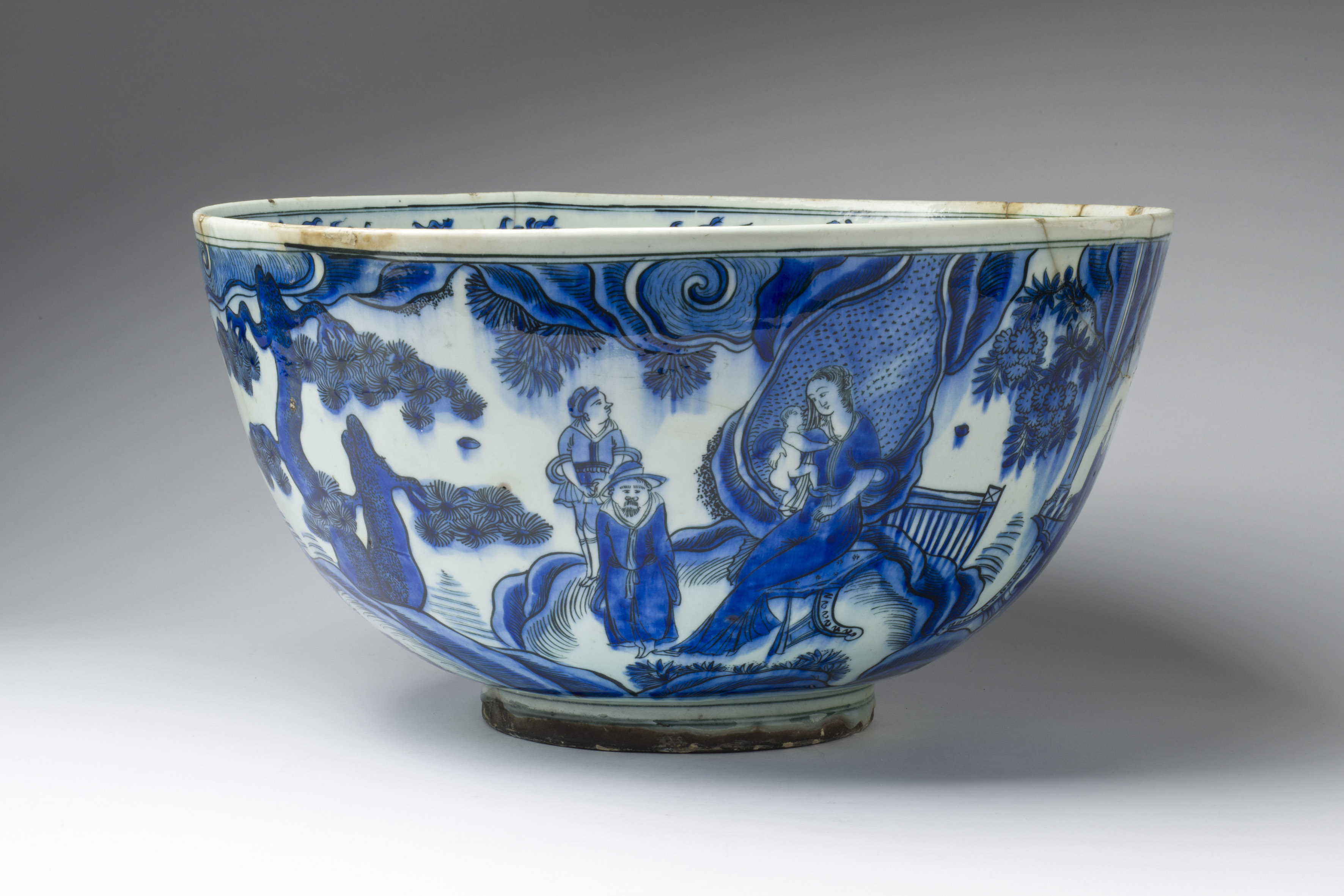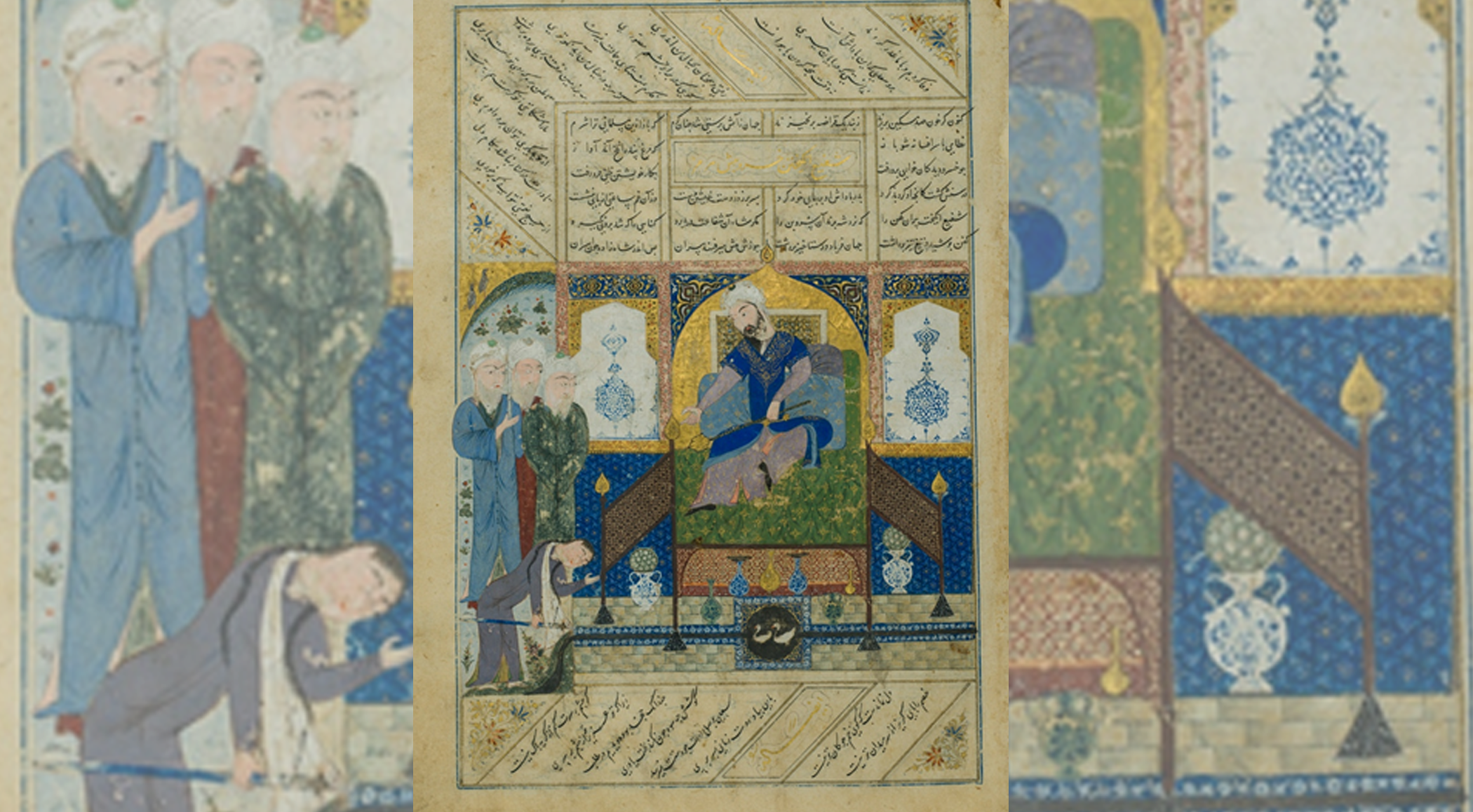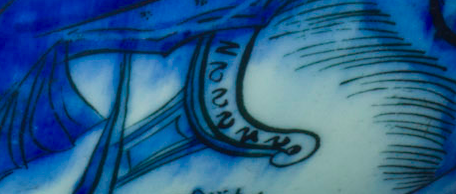en
- de
- en
Chinese blue and white porcelain is world-renowned. However, blue and white ceramics were not only produced in China, but also in Japan, Vietnam, Iran, Turkey, Egypt, and Europe, for example. It was rare for a fashion to spread across so many different geographical regions and be locally imitated.
We embark on a journey with these fragile pieces and experience a story of trade, innovation, and cultural exchange. At the center of it all is blue and white ceramics from Iran.
Our exploration begins with an extraordinary object from the collection of the Museum for Islamic Art in Berlin. It is a large, white bowl with cobalt blue painting, which was produced in Iran in the 17th century. We want to take a closer look at its detailed depictions: Various people dressed differently are visible against a stylized landscape. The depiction of the large cloud and the pine tree is reminiscent of Chinese painting. On the right side, a woman with a child in her arms is painted. Here, the depiction recalls Christian representations of Mary with the baby Jesus.
This piques our curiosity: Why was such a mixture of artistic styles and motifs chosen? To answer this question, let's first consider the history of blue and white ceramics in global trade.
Global trade
Chinese blue and white porcelain in west asia
Since the 3rd century AD, ceramics in China were glazed with pigments made from iron (brown), copper (green), or cobalt (blue). However, paintings in delicate blue on pure white porcelain under a transparent glaze were a new and surprising achievement at the beginning of the 14th century. During this time, the vast territory of the Mongol Empire opened up markets from China to the Near East. Chinese blue and white porcelain became one of the most traded goods in West Asia during this period, including in present-day Iran, Turkey, and Egypt.
The mausoleum of Sheikh Safi ad-Din in Ardabil, located in northern Iran today, includes a porcelain house (chinikhane), a building dedicated solely to the display of porcelain. Shah Abbas I (1571-1629) donated over a thousand pieces of Chinese blue and white porcelain to the shrine.
Blue and white ware in Persian paintings
This illuminated manuscript from the year 1420 depicts the meeting between the Persian king Shahrukh and his son Baisunqur at the court. Several vessels made of blue and white porcelain are displayed on the ground, illustrating the value attributed to Chinese porcelain.
Trade with Europe
In the 16th century, large quantities of Chinese blue and white porcelain first reached Europe. Initially, it was Portuguese traders, later Dutch companies, which, through the East India Company, dominated maritime trade with India and China. Thus, a group of Chinese export porcelain that arrived in Europe by ship is still referred to as "Kraak porcelain," named after the Portuguese word for ship ("carrack"). The craze for Chinese blue and white porcelain reached its peak in Europe in the 17th and 18th centuries. Local workshops also produced blue and white ceramics and copied Chinese motifs during this time.
PORTUGUESE MEET WITH IRANIANS
In the 16th century, the Portuguese took control of crucial trade routes linking the Persian Gulf, the African coast, and the west coast of India. These routes had previously been controlled by Arab merchants. The Portuguese operated from Malacca (Malaysia), engaging in trade with the Far East and transporting Chinese goods from the Indonesian islands to India.
Later, these goods reached Hormuz, present-day Bandar Abbas on the Persian Gulf, an important port for European traders traveling from East Asia to Europe. In 1622, Hormuz was conquered by the Anglo-Persian alliance. This allowed porcelain destined for Europe to enter Iran and begin to spread to other parts of the Islamic world.
This anonymous 16th century Portuguese illustration present in the Códice Casanatense, now stored in the Biblioteca Casanatense in Rome, shows people of Persian origin from the Kingdom of Hormuz.
A close reading on the bowl
The bowl has a diameter of 45.7 cm and weighs around 6 kilograms. But what was it used for?
It is likely that bowls like this were made for feasts and large banquets. As we observed at the beginning, the painting on the bowl is particularly noteworthy. The landscape incorporates many elements from Chinese art, such as the clouds stylized in the form of circles, and the rock upon which the figures stand serves as a stage.
Have You Also Noticed The Figures In The Picture?
On the bowl, eleven figures are depicted, each unique in their gestures and clothing: On the left, a young man riding an ox, and on the right, another tipping his hat in greeting – the diversity is fascinating!
The woman with the small child in her arms reminds us of a central, recurring pair in Christian European painting: the Virgin Mary and the baby Jesus.
The figure on the right is playing a lute and wearing a European hat. However, it's uncertain whether this figure represents a European or an Iranian dressed in European clothing.
A SURPRISING DETAIL!
Under the seat of mother with her child, we can discern pseudo-Latin characters. This suggests that the image may have had a European template.
ISFAHAN: THE CITY AT THE CROSSROADS
The fusion of European figures with Chinese landscapes on this bowl raises questions. Possible answers are provided by the city of Isfahan, which was the flourishing capital of the Safavid Empire in the 17th century. It tells us a story of cultural convergence and artistic exchange.
There is an old Persian proverb: اصفهان نصف جهان [Isfahan, half of the world].
As the capital of the Safavid Empire, Isfahan was one of the largest and most important cities in the Middle East in the 17th century. It is situated at the crossroads of major north-south and east-west trade routes that traverse Central Asia. European diplomats, Catholic missionaries, traders, and travelers visited Isfahan. Triggered by these cultural contacts, European clothing became a new fashion. Thus, in Persian painting, there are many figures dressed in European attire. They can be found on the walls of the Chehel Sotun Palace in Isfahan as well as on Persian ceramics.
These murals are from the Chehel Sotun Palace. The male figure on the left wears a short coat with a surcoat, Spanish trousers, and a hat with a large brim and feather. This clothing is modeled after European fashion.
Made in C̶H̶I̶N̶A̶ Iran
In early 17th century, local workshops in Iran began producing their own blue and white ceramics. Many vessels closely resembled their Chinese counterparts in form and decoration, making them indistinguishable from the ones of Chinese origin. However, the main difference was that they were made from a ceramic body (quartz fritware) rather than porcelain.
From a European traveler of the 17th century, we know that Chinese porcelain intended for shipment to Europe was mixed with ceramics from Iran. At a time when the Ming Dynasty in China (1368-1644 AD) was in decline, porcelain production was insufficient to meet the high demand from Europe. Iranian artisans seized this opportunity and successfully served the market.
AN INTRIGUING DETAIL!
How can one distinguish whether a ceramic was made in Iran or in China?
On the bottom of Chinese ceramics, there are so-called porcelain marks. Persian potters imitated this Chinese tradition. In Chinese porcelain, this stamp typically consists of Chinese characters (example on the right). Under the left bowl, we see a pseudo-mark that does not represent actual Chinese characters but rather simple strokes that give the appearance of Chinese. This detail became a key to recognizing whether a piece was made in Persia or in China. Those who were more familiar could also recognize whether it was porcelain or fritware.
Further information on trade
Long before Christopher Columbus reached the American continent and the Portuguese reached India, trade between the Near and Far East by land and sea had a centuries-old tradition. Chinese porcelain had been exported to the Middle East since the 9th century. On the other hand, Chinese artisans relied on the blue cobalt pigment imported from Iran. Eventually, they developed their world-famous blue and white porcelain from it, which has remained popular in large parts of the world for centuries, up to the present day.
ABOUT THE AUTHOR
Dr Shunhua Jin researches on Islamic material culture in China, including Chinese mosques and manuscripts. She also explores cultural transfer between eastern Asia and the Islamic world, with a specific interest in artistic exchange between China and Iran during the 16th and 17th centuries. She wrote this essay during a research stay with the international fellowship program at Staatliche Museen zu Berlin (2023-2024).



